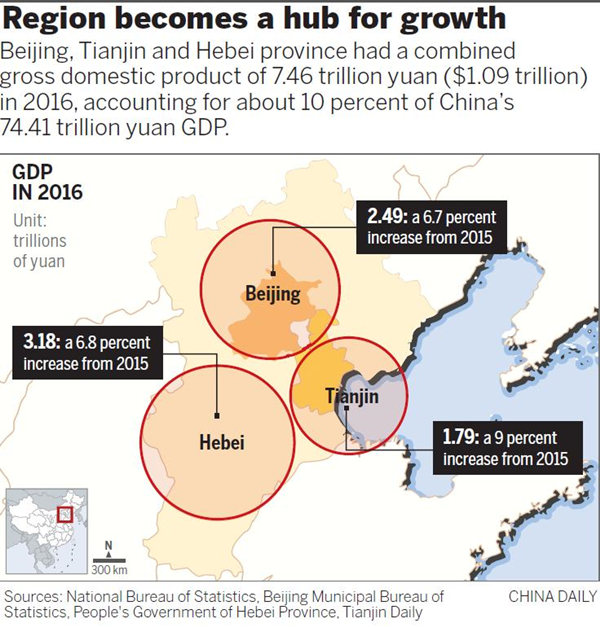Capital area to be economic dynamo
By LIU WEIFENG,WANG YU,,OUYANG SHIJIA | China Daily | Updated: 2017-02-20
Integrated Beijing, Tianjin, Hebei creating global city cluster
The integrated and synergetic development of Beijing, Tianjin and Hebei province— a national strategy preparing the way for the country's next growth engine — is expected to create a global city cluster and fuel the growth of the whole Bohai Bay area in the coming decades, according to China's top economic planner.
"The significance of the Beijing, Tianjin and Hebei synergetic development and integration strategy lies in the fact that it is not only enhancing the growth efficiency and effectiveness of related cities, but also driving the capital region into becoming a world-class city cluster and further boosting the entire Bohai Bay area of North China," Xu Shaoshi, head of the National Development and Reform Commission, said in an interview with China Daily on Sunday.
The Beijing-Tianjin-Hebei area has higher population density in major cities than the Yangtze River Delta and has to rely on a new growth pattern that strikes a balance between space restraints, economic growth and cooperative, synergetic development, Xu said.
Initiated in 2014 by President Xi Jinping, the national strategy of synergizing the development of Beijing, Tianjin and Hebei stemmed from the long-held goal of ensuring balanced and integrated joint development of the area.
Three years later, substantial progress has been made and more innovation-driven projects and industry upgrades are in the pipeline.
This year, the region will witness a dozen integrated projects put into place outside Beijing, and part of the Beijing municipal government moving into an administrative subcenter on the outskirts of the city.
These projects include the new Beijing Daxing International Airport, the second phase of the Shougang Jingtang steel complex at Caofeidian, and several high quality environmental-protection and traffic projects.
The Tianjin Pilot Free Trade Zone and Beijing Zhongguancun Science Park also will play a more proactive role, encouraging cross-border investment and financing, equity transactions and entrepreneurship within the region by unifying rules and regulations, according to Xu.
Taking advantage of the free trade zone and port facilities, Tianjin is coming up with innovative ways to help enterprises from Beijing and Hebei go overseas, said Shen Lei, an official with Tianjin Dongjiang Free Trade Port Zone.
As part of the capital's regional integration strategy, Beijing is tasked with aiding Tianjin and Hebei in upgrading their manufacturing capacity and enhancing their innovation capabilities.
"Thanks to abundant talent and research and development advantages, Beijing will fuel joint development of the whole region. We encourage companies to invest in Hebei and Tianjin, generating jobs and benefiting local residents," Beijing Mayor Cai Qi said.
In 2016, Beijing's investment in Tianjin and Hebei skyrocketed. Enterprises from Beijing invested 114 billion yuan ($16.6 billion) in Hebei and almost 90 billion yuan in Tianjin, up 100 and 26 percent year-on-year. High-tech oriented investment from Beijing to Hebei and Tianjin hit 15.4 billion yuan in 2016, up 38.7 percent year-on-year.
The Cangzhou Hyundai plant in Hebei province, the fourth factory of Beijing Hyundai Motor and its first outside Beijing, is the largest integrated industrial project in the region, with a total investment of 7.4 billion yuan.
The factory opened in October, directly creating more than 3,000 local jobs. Lang Jiawei, deputy general manager of Beijing Hyundai, said the Cangzhou plant will spur a huge auto industrial chain valued at 100 billion yuan in Hebei.
As it helps neighboring regions, Beijing also is fine-tuning its economic structure and seeking a transformation from manufacturing powerhouse to a hub for more high-end cultural, financial and service industries, according to Wang Haichen, an official with the Beijing Development and Reform Commission.
Wang says the integration strategy is a wise move to seek balanced improvement in the business environment among different regions, and as a result, to attract more foreign direct investment.
Zhou Mi, a senior research fellow at the Chinese Academy of International Trade and Economic Cooperation, agreed. "With the improved business environment and mechanism, the three regions as a whole will attract more resources."
Newly released statistics show that the aggregate GDP of Beijing, Tianjin and Hebei accounted for more than 10 percent of the country's total in 2016, reaching 7.46 trillion yuan.
China is seeking more coordinated and balanced growth, and many regional stimulus strategies have been unveiled in recent years.
The Yangtze River Delta, with Shanghai as its primary engine, tops China's regional development powerhouses, with GDP reaching 17.9 trillion yuan, 24 percent of the national total last year.
But under its new strategy, the Beijing-Tianjin-Hebei area is expected to catch up and grow into a world-class city cluster with robust economic power, said Cao Heping, an economist at Peking University.
Contact the writers at wangyu@chinadaily.com.cn
@AndrewJin ,
@ahojunk ,
@Nan Yang ,
@oprih
I guess there was a thread dedicated on the Beijing-Tianjin-Hebei city cluster. But I could not locate it. @ahojunk may move this post to the concentrated thread, if possible.








